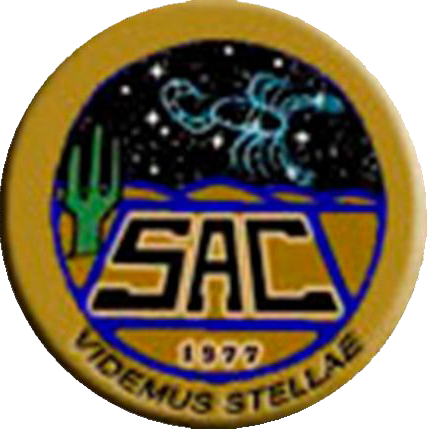Observing Sheets
Click on the desired sheet to view the pdf.
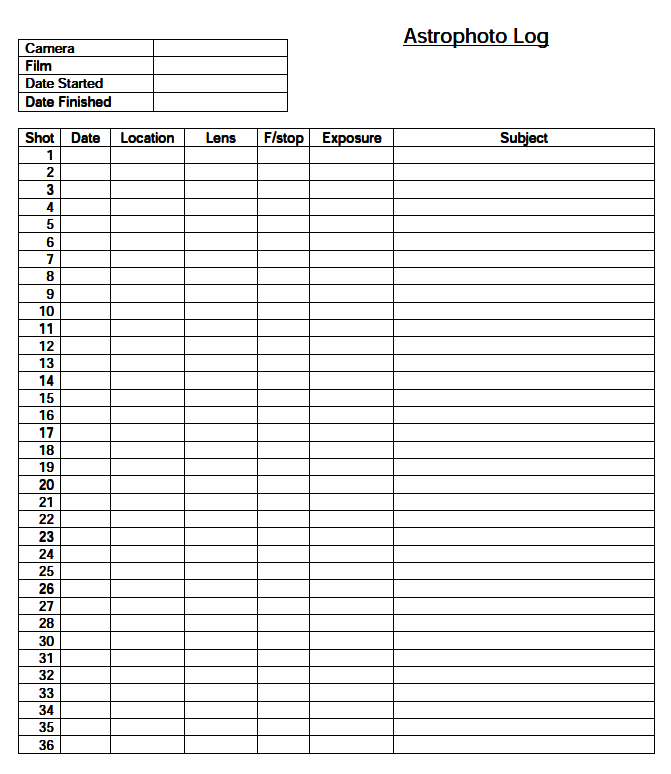 |
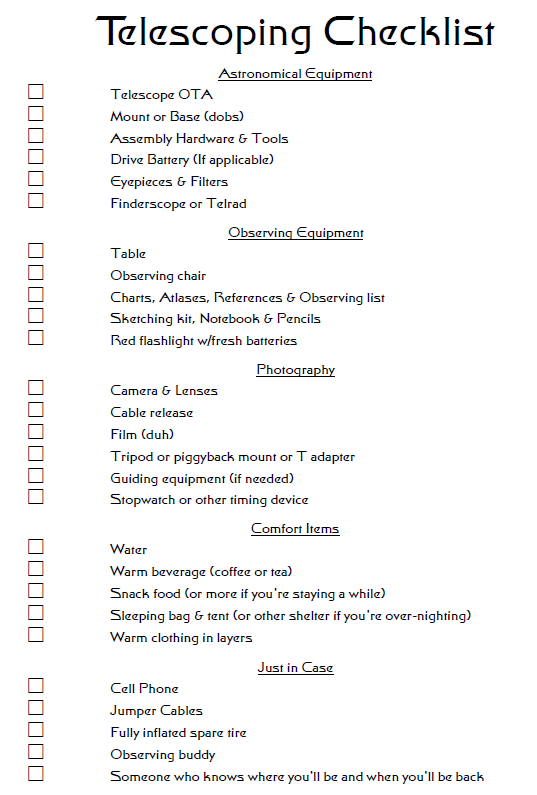 |
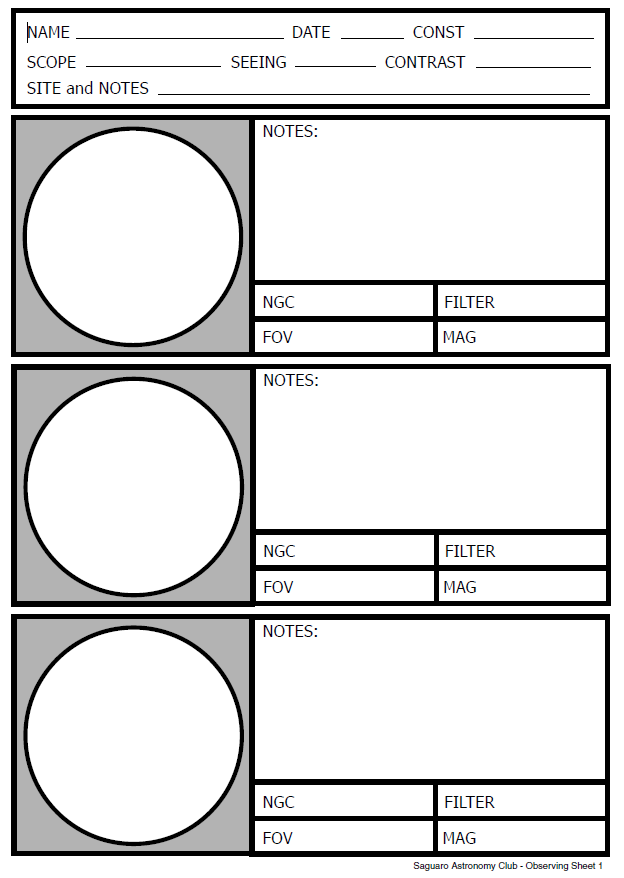 |
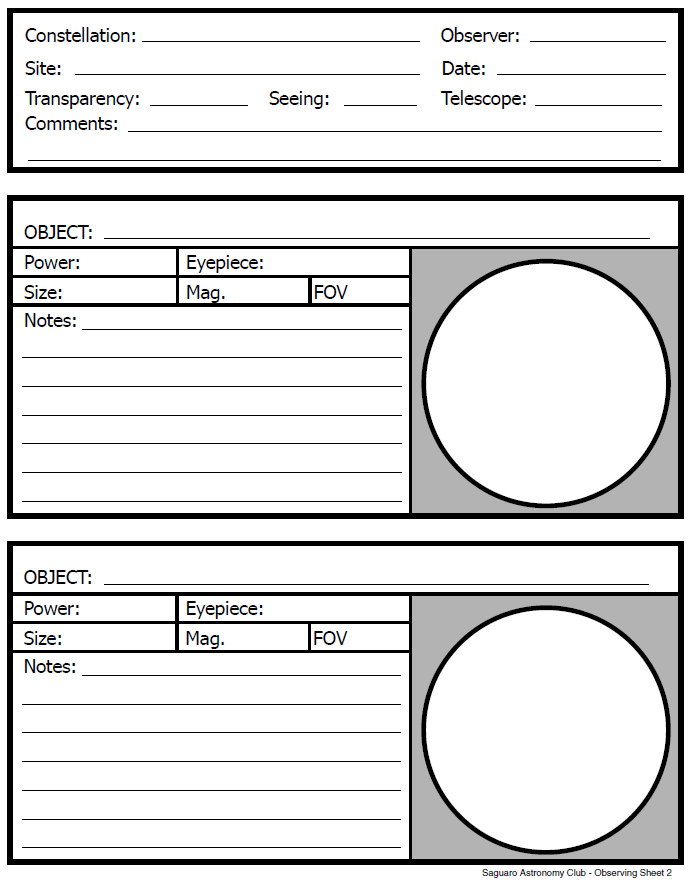 |
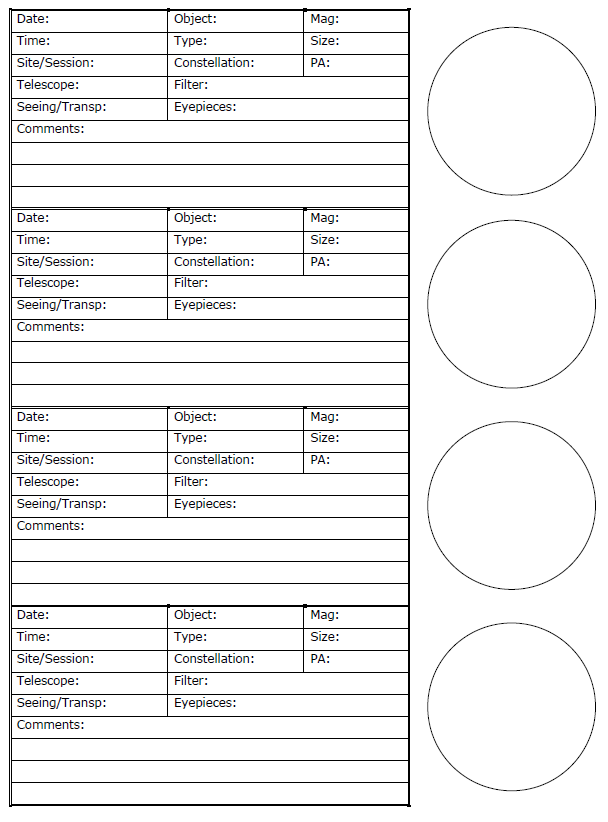 |
| Camera Log | Telescope Log | Observing Sheet 1 | Observing Sheet 2 | Observing Sheet 3 |
Databases
Saguaro Astronomy Club Database version 8.1
March 22, 2010
stevecoe@cloudynights.com
Click here to download the zip file.
This club project started many years ago, when we wanted a listing of the brightest deep sky objects on our computers with 64KB of memory on floppy disks. Thinking it would be an easy task, here we are more than 25 years later, still maintaining and updating a much larger listing of information about what to observe at the telescope. How far we have come from the list of the brightest 300 objects contained within Burnham’s Celestial Handbook, all typed in on my Apple II+. Time flies. As always, if you find an error, please let us know.
This ZIP file contains the following 7 files:
- README.TXT file.
- SACDOC.TXT is the documentation for the SAC database. There is information here on the data fields and what the data means. Please spend some time reading this info before trying to utilize the database, it will help you to use this data effectively.
- REVHIST.TXT is the revision history, a short file about the various releases of the SAC database.
- POTPOURRI.TXT is a set of information about a wide variety of astronomical phenomena from white dwarf stars, red stars, meteor showers, common names and more. These are useful files, but they did not fit the information style of the main database.
- SAC_DeepSky_81.XLS is version 8.1 of the SAC data as an Excel spreadsheet. There are lots of possible ways to search and sort the data in this popular spreadsheet. It contains information on over 10,000 deepsky objects.
- SAC_DeepSky_81_QCQ.TXT is version 8.1 of the Saguaro Astronomy Club database in quote, comma, quote delimited form. This is also called CSV for comma separated variable. Any modern database manager or spreadsheet will import the data in this format.
- SAC_DeepSky_81_FENCE.TXT is version 8.1 of the SAC data as a text file that has vertical bars between the fields. You can search and sort the data with a text editor.
SAC wishes to thank all the people who have spent many hours searching for, and correcting, errors in the NGC. Their work is reflected in this release of the SAC database.
A small fraction of the number of objects still persist as NONEXISTENT, compared to the beginnings of this database. Brian Skiff of Lowell Observatory has been a constant help with a variety of information about deep sky objects. Stephen Michael Schimpf spent much time with the NOTES field, finding errors and trying to make the data more consistent.
Besides myself, I am going to list the dedicated group of people who have helped keep this an up to date and useful database: Bill Anderson, A.J. Crayon, David Fredericksen, Jack Jones, Jay LeBlanc, Matt Lutinnen, Peter Argenziano, Paul Lind and Paul Dickson.
Thank you to the skill, knowledge and expertise of all who helped the Saguaro Astronomy Club create this listing of what to observe in the deep sky.
See the NOTE at the bottom of the Revision History, we will keep an updated errata file at the SAC web site from now on and allow users to update their version 8.1 files as needed.
Steve Coe
Database manager
Saguaro Astronomy Club
Saguaro Astronomy Club Double Star Database version 4.0
July 4, 2008
Click here to download the database zip file.
Many members of our astronomy club have always enjoyed the beauty of multiple stars and in an effort to provide a list of these objects, this project was started. We are not foolish enough to believe that it is complete, but it should be a good starting point for many amateur double star observers with modest telescopes.
The previous versions of the SAC double star database were created by starting with a large professional set of data, usually the Washington Double Star (WDS) catalog. We found that approach to provide plenty of stars but we found that size just created an overwhelming observing list.
So, this time we came at the problem from the other direction. Instead of creating a double star database from a huge file, we would put together the information from a wide variety of modest sources and created a larger file of multiple stars that have been discussed in the astronomical literature. In other words — someone at some point said that these stars are worth observing.
There are three versions of the database in this release, in an effort to provide the users of the data the most useful format for their computer. The “fence” version is delimited by a vertical bar (|), or fence, between each field. The “QCQ” version is a comma delimited (CSV) version so the user can easily import it into a variety of spreadsheets or database managers. The third version is an Excel spreadsheet.
Saguaro Astronomy Club Red Stars Database version 2.0
July 7, 2008
Click here to download the database zip file.
For as many years as we have been observing the sky, SAC members have enjoyed viewing stars with color. These tints are subtle and demand training your eye to see them, but we consider it worthwhile so that you can start to see stars as something other than white. Even with the naked eye some bright stars are ruddy in color; Antares and Betelgeuse are the most obvious examples. Adding a telescope to the pursuit of color in stars means that many more stars can be seen in color. Most often the colors viewed are mixtures of yellow, orange and red.
Several avid observers from years past have created a numeric scale for judging color in stars. I will provide you with just one of these, from J.F.J. Schmidt, who was the head of the observatory in Athens, Greece for many years. Using a 6 inch refractor he discussed the colors he saw as “0 is pure white, 4 is pure yellow, 6 is deep golden yellow, 8 is orange and 10 is pure red”. He said that he never gave any star a rating of 10.
The spectra of a star tells much about the chemistry, temperature and other physical conditions of the star. The coolest “normal” stars are in spectral types K and M. These stars often appear medium yellow to light orange to many observers. The carbon stars are stars that are surrounded by a cloud of carbon soot. This cloud filters out most of the blue light from the surface of the star and makes them much redder to an observer. These stars are given the obvious designation “C” and the less obvious “N”.
SAC members started this pursuit of tinted stars with a listing of red stars we distributed as part of “Potpourri”, included in the zip file with the SAC Deep Sky Database. That listing contains 70 stars with very simple information on each. This list is a greatly expanded version of that simple beginning. As always, if you know any data that would fill in gaps in this database please get in touch.
- Bill Anderson helped with the creation of the database format and checked for accuracy.
- Steve Coe wrote the file you are reading and searched a variety of sources for the information that was added to this database.
- Alister Ling helped with checking for accuracy and helped with this read me file.
- Brian Skiff provided several excellent sources of tinted stars.
The zip file includes:
- A “read me” information text file.
- A data set that is a simple text file delimited with a vertical bar (|), or “fence” for ease of use in a text editor.
- A comma delimited data set. This file is marked with “QCQ” in its filename. This type of file can be imported into virtually any database manager program.
- A data set in an Excel spreadsheet file
Saguaro Astronomy Club Asterisms Database Version 3.2
December 10, 2013
The Asterisms data that accompanies this document contains information on all the known asterisms (to the group of people I observe with;-)
The data are arranged in the following order:
- NAME, the name of the asterism.
- CON, the constellation in the IAU format.
- RA, the Right Ascension (2000) in hours, minutes and decimal minutes.
- DEC, the Declination (2000) in degrees and minutes.
- MAG, the magnitude of the asterism.
- SIZE, the size in degrees (d) or in arc minutes (‘) of the asterism.
- TIR, the chart number of the asterism on the Star Atlas 2000 by Tirion.
- BSA, the chart number of the asterism on the Bright Star Atlas.
- NOTES, other information about the asterism.
Tip: the SIZE field is going to determine the instrument you will want to use for observing the asterism. Very large asterisms such as the “Big Dipper” or “Winter Triangle” are going to be best with the naked eye. Medium size asterisms such as “Orion’s Sword” or the “Swoosh” in Scutum, will be best with binoculars or a wide field telescope. The smaller asterisms such as “Little Queen” or “Backwards 5” will be best in a telescope. Use the best instrument to get the best view.
Asterisms are fun groupings of stars that do not constitute an entire constellation; some of these objects are on the border between multiple constellations. But, with a wide field instrument or some binoculars, there is a lot to see.
Do not count on the data here being precise. I measured the size and magnitude of many of these asterisms using my planetarium program, Sky Map Pro. I do believe that most of the positions are good enough to get the asterism into a wide field eyepiece in most telescopes.
I am often at the www.cloudynights.com web site. Contact me there if you have another asterism to add or if you have found an error to report.
Clear Skies;
Steve Coe
The Saguaro Astronomy Club’s Deep Sky Database, Version 7.2
Contains information on over 10,000 star clusters, galaxies, and nebulae of all types.
Click here to download the ZIP file.
The Saguaro Astronomy Club’s Double Star Database
Version 4.0 contains information on over 10,000 multiple star systems.
Click here to download the ZIP file.
Each of these databases contains the information in ASCII text format.
The Double Star Database also includes a program by Dan Ward to create an observing list. This program creates reports, views entries and generates data extracts from that database for the purpose of creating observing lists or researching double star details.
Miscellaneous Files
Binary Star Calculator
by Brian Workman. (ZIP file)
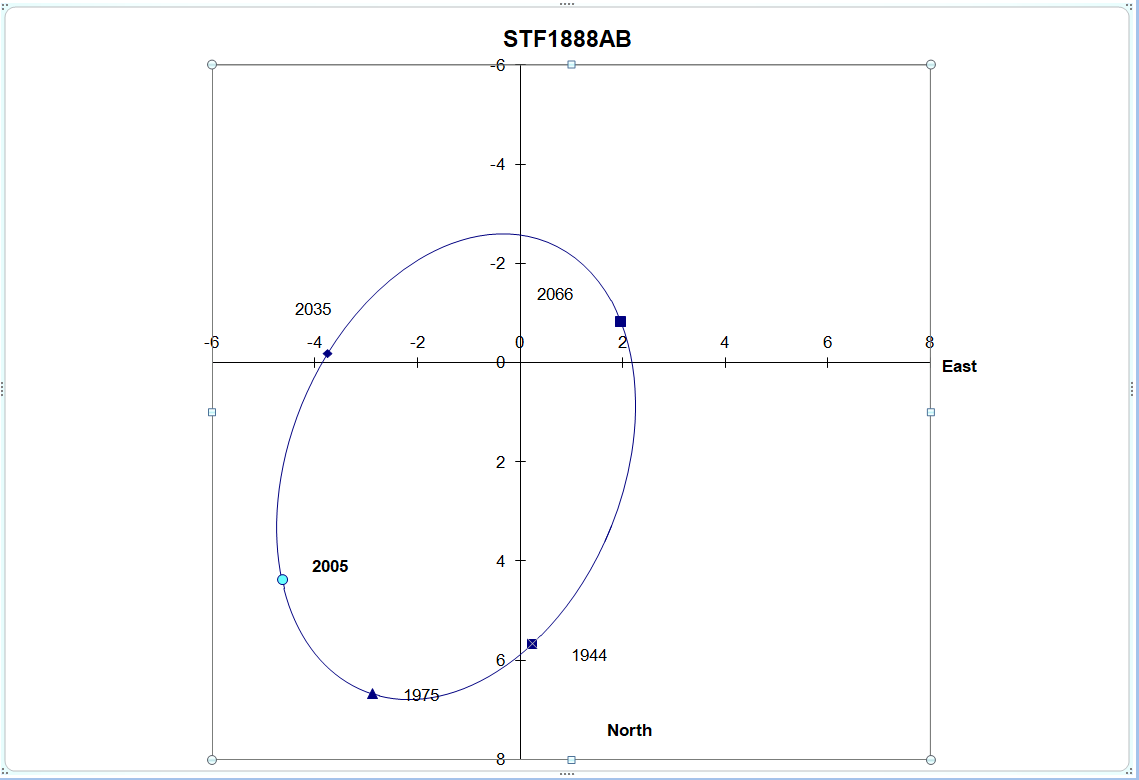
This Excel spreadsheet allows a user to calculate the position angle and separation of a visual binary star for a given date. The orbital path of the secondary star about the primary is also plotted.
This (third) version includes the “Sixth Catalog of Orbits of Visual Binary Stars” by William I. Hartkopf & Brian D. Mason, obtained from the USNO Web site and incorporates a macro that automatically scales the orbital plot such that the X axis scale and Y axis scale are equal, correcting a deficiency with the earlier versions.
The spreadsheet will work on both Mac and PC, but the macro has not been tested on versions of Excel older than Excel97.
Best 110 of the NGC
Best of the NGC – The Book. Link to the page describing this book, with download link.
The SAC-Tracker
Link to a page with instructions for building the SAC-Tracker.![]()
HNSky
HNSky is an electronic planetarium program from Han Kleijn. It can map a variety of stellar and non-stellar databases, some of which are quite large (meaning it takes a long time to download), so only the smaller databases are included on this site. To access the larger databases & FITS images, please see the link at the bottom of this page. HNSky is free-ware. Read the help file and Enjoy!
1) HNSKY For Win95/95/98/ 2000/NT/ME/XP Basic package HNSKY230.EXE (v2.3.9i) complete with small SAO star database, comet and asteroid and deepsky databases. With modern installation program.
The deepsky database contains 25500 deepsky objects based on
SAC 7.2, the Wolfgang Steinicke revised NGC & IC, Kent Wallace SEC (PN) database and many galaxies from LEDA.
2) Double star supplement :Based on SAC2.1/WDS containing more then 10000 double stars.
SAC Supplemental Files for HNSky
A) Objects Viewable From Metro Phoenix, “The Urban List”
C) Best 110 Objects Beyond the NGC
For additional databases, both stellar and non-stellar, please see:
http://www.hnsky.org/software.htm
History of the Saguaro Astronomy Club
Click here to view a summary document of the club’s history.
SAC 110 Best Lunar Objects
(list and log by Jimmy Ray)
Click here to download
Touring the Trumpler Classes
an article by Richard Harshaw
Click here to download
The Complete Burnham’s Celestial Handbook observing list
(by Steve Coe)
Click here to download text file
Click here to download Excel spreadsheet
Double Star for Seeing Test, Spring 2004
Click here to download the pdf document.
Star charts and information on several double stars in the spring sky. We would like to conduct a seeing test to see how these stars can be split with the telescopes available to SAC observers over the next several months.
